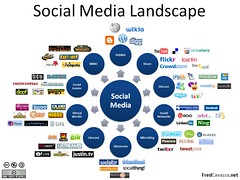 @Karawynn – the person behind @pocketmint – wrote this rather … familiar… post about social media engagement. tl;dr = It’s easy to get overwhelmed, no matter what topic you’re interested in.
@Karawynn – the person behind @pocketmint – wrote this rather … familiar… post about social media engagement. tl;dr = It’s easy to get overwhelmed, no matter what topic you’re interested in.
I left a comment there that says some of the same things, but I wanted to expand (and link) here. It’s something we hear a lot on panels for writers.
Abby from ForceOfHappiness basically started off by replying that you should deliberately limit your consumption and obligations. And she is totally right. The mechanics of how to go about doing that is up to you.
I’ll start by mentioning that my social media “map” is a little more complex than most people’s. Back in March, I showed you what it looked like then…
It’s actually a tiny bit more complex now, since Alliteration Ink has its own Twitter account. I do think it’s important to have accounts on the major networks, even if you’re not a fan of them, and have your material go to where people are, though. Or at least, a link for them to click on.
 It’s also worth noting that I (try to) have items show up more than once, but 6-12 hours apart. In general, something like 10% of your audience sees any particular post on Twitter or Facebook. Maybe. And that’s largely because people are looking at it at different times. So I’ll schedule a blog post to go up around noonish, then maybe restart the chain of notifications via a G+ share in the mid-to-late evening. (G+ -> Twitter -> Facebook)
It’s also worth noting that I (try to) have items show up more than once, but 6-12 hours apart. In general, something like 10% of your audience sees any particular post on Twitter or Facebook. Maybe. And that’s largely because people are looking at it at different times. So I’ll schedule a blog post to go up around noonish, then maybe restart the chain of notifications via a G+ share in the mid-to-late evening. (G+ -> Twitter -> Facebook)
ATTITUDE: I don’t presume my peers read my blog(s), and vice versa. I will often begin a conversation with a peer saying *exactly that*. Sometimes they’ll have read the post I’m going to reference – great! Sometimes not. And – I can’t stress this enough – vice versa. Making the assumption that someone reads your blog smacks of pure ego. You’re a content *creator*, not a consumer. And if you’re finding that content consumption is cutting into your creation time, you have to re-evaluate.
CONSUMING: I rarely scroll back on Twitter or Facebook – it’s simply not possible. SocialFixer helps a lot with FB, but it’s still a pain. If it’s something that’s actually worth your attention, multiple people/sites will pick it up – and then it’ll hit your radar. Twitter lists are your friend. Curate them ruthlessly. SocialFixer can actually do a better job of filtering Facebook content than any “friend” list (though it’s harder to set up at first), which can help narrow it down. There are currently only a few people whose tweets go through to text messages so I see every one of them – and one of them is my girlfriend.
TOOLS: SocialFixer (makes FB navigable), Tweetdeck (multiple columns, list per column), Turpial (likewise, lighter-weight), Google Plus Wide Fork (userstyle to make G+ easier to navigate).
PRODUCING: Mapping out the propagation network wasn’t a luxury – it was a necessity. My blog is my main content source, though I have a couple of Tumblrs that *only* serve for specific types of content. Again, you’re going to where people are. While some of us are spread across multiple accounts and networks, many people aren’t. I do make an attempt to not duplicate content across accounts – so that people who “like” my business page, my author page, and are my Facebook friend don’t get three identical posts at the same time. (They might show up on all three – but spread out throughout the day… so they might only actually SEE one of the posts.)
In general: Main blog == primary new content, general purpose. Tumblrs == specific-content blogs.
TOOLS: ManageFlitter (G+ to Twitter), Twitterfeed (RSS->Twitter), RSSGraffitti (RSS -> Facebook), Feedburner (turn blogs into RSS). RSS also propagates my posts to GoodReads, Amazon, and (via post-by-email) to LiveJournal. I’ve got at least one fan who reads at each of those places, which means that the time to send those posts there was totally worth it.
This setup means that after spending an afternoon figuring it out and an evening setting it up, most of the time it operates in the background without any intervention from myself.
Have I missed anything? What do you do? What tools do you use?

